Experiment and Model of Conductivity Loss of Fracture Due to Fine-Grained Particle Migration and Proppant Embedment
Abstract
:1. Introduction
2. Fracture Conductivity Damage Model
2.1. Fine-Grained Particle Migration Formulation
2.2. Embedment Formulation
2.3. Permeability Decline
2.4. Boundary Condition and Solution
3. Experiments on Fracture Conductivity Damage
3.1. Experiment Procedure
- (i)
- The conductivity cell was paved with proppant. The fine-grained particles were mixed with water in an intermediate container with a stirrer at the bottom of the container, which kept the suspension stable. Two slices of rock plates were used to simulate a real rock fracture.
- (ii)
- The desired closure pressure was applied to the plates using a hydraulic pump. The constant-flux pumps were then push-pistoned inside the intermediate container to draw the suspension into the conductivity cell.
- (iii)
- After a period, the pressure drop between the front and end of the cell was gauged. The distribution of the coal fine-grained particles in the proppant pack was then observed. The experimental data were analyzed.
3.2. Result and Discussion
3.3. Experiment Comparison with Published Data
4. Filtration Coefficient of Particle Transport
4.1. Development of Network Model
4.1.1. Particle Motion
4.1.2. Fluid Flow
4.1.3. Effective Radius
4.2. Calculation Process
4.3. Analysis of Influencing Factors of Filtration Coefficient
5. Conclusions
Author Contributions
Funding
Institutional Review Board Statement
Informed Consent Statement
Data Availability Statement
Acknowledgments
Conflicts of Interest
References
- Lehman, L.V.; Blauch, M.E.; Robert, L.M. Desorption enhancement in fracture-stimulated coalbed methane wells—SPE 51063. In Proceedings of the SPE Eastern Regional Meeting, Pittsburgh, PA, USA, 9–11 November 1998. [Google Scholar]
- Zou, Y.S.; Zhang, S.C.; Zhang, J. Experimental method to simulate coal fines migration and coal fines aggregation prevention in the hydraulic fracture. Transp. Porous Media 2014, 101, 17–34. [Google Scholar] [CrossRef]
- Alramahi, B.; Sundberg, M.I. Proppant embedment and conductivity of hydraulic fractures in shales. In Proceedings of the 46th U.S. Rock Mechanics/Geomechanics Symposium, Chicago, IL, USA, 24–27 June 2012. [Google Scholar]
- Bedrikovetsky, P.; Vaz, A.; Machado, F.; Zeinijahromi, A.; Borazjani, S. Skin due to fines mobilization, migration, and straining during steady-state oil production. Pet. Sci. Technol. 2012, 30, 1539–1547. [Google Scholar] [CrossRef]
- Guo, Z.; Hussain, F.; Cinar, Y. Physical and analytical modelling of permeability damage in bituminous coal caused by fines migration during water production. J. Nat. Gas Sci. Eng. 2016, 35, 331–346. [Google Scholar] [CrossRef]
- Bai, T.; Chen, Z.; Aminossadati, S.M.; Li, L.; Liu, J.; Lu, H. Dimensional analysis and prediction of coal fines generation under two-phase flow conditions. Fuel 2017, 194, 460–479. [Google Scholar] [CrossRef]
- Coronado, M.; Díaz-Viera, M.A. Modeling fines migration and permeability loss caused by low salinity in porous media. J. Pet. Sci. Eng. 2017, 150, 355–365. [Google Scholar] [CrossRef]
- Sen, T.K.; Khilar, K.C. Review on subsurface colloids and colloid-associated contaminant transport in saturated porous media. Adv. Colloid Interface Sci. 2006, 119, 71–96. [Google Scholar]
- Xu, X.F.; Hao, J.; Yu, L.; Deng, Y.R. Fuzzy optimal allocation model for task-resource assignment problem in collaborative logistics network. IEEE Trans. Fuzzy Syst. 2019, 27, 1112–1125. [Google Scholar] [CrossRef]
- Lagasca, J.R.P.; Kovscek, A.R. Fines migration and compaction in diatomaceous rocks. J. Pet. Sci. Eng. 2014, 122, 108–118. [Google Scholar] [CrossRef]
- Zeinijahromi, A.; Farajzadeh, R.; Bruining, J.; Bedrikovetsky, P. Effect of fines migration on oil–water relative permeability during two-phase flow in porous media. Fuel 2016, 176, 222–236. [Google Scholar] [CrossRef]
- Xu, X.F.; Hao, J.; Zheng, Y. Multi-objective artificial bee colony algorithm for multi-stage resource leveling problem in sharing logistics network. Comput. Ind. Eng. 2020, 142, 106338. [Google Scholar] [CrossRef]
- Herzig, J.P.; Leclerc, D.M.; Le Goff, P. Flow of Suspensions through Porous Media—Application to Deep Filtration. Ind. Eng. Chem. 1970, 62, 8–35. [Google Scholar] [CrossRef]
- Bedrikovetsky, P.; Siqueira, F.D.; Furtado, C.A.; Souza, A.L.S. Modified particle detachment model for colloidal transport in porous media. Transp. Porous Media 2011, 86, 353–383. [Google Scholar] [CrossRef]
- Sharma, M.M.; Yortsos, J.C. Fines migration in porous media. Aiche J. 1987, 33, 1654–1662. [Google Scholar] [CrossRef]
- Zhang, J.; Kamenov, A.; Zhu, D.; Hill, A.D. Development of new testing procedures to measure propped fracture conductivity considering water damage in clay-rich shale reservoirs: An example of the Barnett Shale. J. Pet. Sci. Eng. 2015, 135, 352–359. [Google Scholar] [CrossRef] [Green Version]
- Tan, Y.; Pan, Z.; Liu, J.; Wu, Y.; Haque, A.; Connell, L.D. Experimental study of permeability and its anisotropy for shale fracture supported with proppant. J. Nat. Gas Sci. Eng. 2017, 44, 250–264. [Google Scholar] [CrossRef]
- Zheng, X.; Chen, M.; Hou, B.; Ye, Z.; Wang, W.; Yin, C.; Chen, X. Effect of proppant distribution pattern on fracture conductivity and permeability in channel fracturing. J. Pet. Sci. Eng. 2017, 149, 98–106. [Google Scholar] [CrossRef]
- Mahmood, S.; Ehsan, K.; Ahmad, F.; Bahram, D. A mechanistic study of smart water injection in the presence of nanoparticles for sand production control in unconsolidated sandstone reservoirs. J. Mol. Liq. 2020, 319, 114210. [Google Scholar]
- Wang, J.; Huang, Y.; Zhou, F.; Liang, X. The influence of proppant breakage, embedding, and particle migration on fracture conductivity. J. Pet. Sci. Eng. 2020, 193, 107385. [Google Scholar] [CrossRef]
- Chen, D.; Ye, Z.; Pan, Z.; Zhou, Y.; Zhang, J. A permeability model for the hydraulic fracture filled with proppant packs under combined effect of compaction and embedment. J. Pet. Sci. Eng. 2017, 149, 428–435. [Google Scholar] [CrossRef] [Green Version]
- Mojarad, R.S.; Settari, A.T. Coupled numerical simulation of reservoir flow with formation plugging. J. Can. Pet. Technol. 2007, 46, 54–59. [Google Scholar] [CrossRef]
- Wang, Z.; Zhou, W.; Shu, T.; Xue, Q.; Zhang, R.; Wiercigroch, M. Modelling of low-frequency acoustic wave propagation in dilute gas-bubbly liquids. Int. J. Mech. Sci. 2022, 216, 106979. [Google Scholar] [CrossRef]
- Huang, F.; Kang, Y.; You, Z.; You, L.; Xu, C. Critical Conditions for Massive Fines Detachment Induced by Single-Phase Flow in Coalbed Methane Reservoirs: Modeling and Experiments. Energy Fuels 2017, 31, 6782–6793. [Google Scholar] [CrossRef]
- Pu, C.S. Micro-Kinetics of Particle Deposition, Dispersion and Migration on the Surface of the Liquid-Solid System; Petroleum Industry Press: Beijing, China, 2008; pp. 52–79. [Google Scholar]
- Zheng, L.S.; Pu, C.S.; Liu, J.; Xu, J.X.; Tian, C.D. Analysis of particle migration in porous media under elastic wave. J. Chongqing Univ. 2016, 39, 101–108. [Google Scholar]
- Li, H.P.; Chen, X.H.; Li, L.C.; Liu, X.J. Particle migration character of unconsolidated reservoir and its influence on oil performance. Fault-Block Oil Gas Field 1996, 3, 31–34. [Google Scholar]
- Ju, B.; Ma, M.; Qiu, X. The mathematical simulation method of migration of fines and clay swell in elastic porous medium. J. Hydrodyn. 2003, 18, 8–15. [Google Scholar]
- Yuan, H.; Shapiro, A.A. Induced migration of fines during waterflooding in communicating layer-cake reservoirs. J. Pet. Sci. Eng. 2011, 78, 618–626. [Google Scholar] [CrossRef] [Green Version]
- Zhou, S.; Zhang, X.; Wu, D.; Di, H. Mathematical Modeling of Slurry Infiltration and Particle Dispersion in Saturated Sand. Transp. Porous Media 2018, 124, 91–116. [Google Scholar] [CrossRef]
- Ju, Y.S.; Ma, X.F.; Wang, L.; Lin, X. Experimental evaluation of conductivity of fracturing in medium and high-rank coalbed. J. China Coal Soc. 2011, 36, 473–476. [Google Scholar]
- Hazlett, R.D. Statistical characterization and stochastic modeling of pore networks in relation to fluid flow. Math. Geol. 1997, 29, 801–822. [Google Scholar] [CrossRef]
- Øren, P.-E.; Bakke, S. Reconstruction of Berea sandstone and pore-scale modeling of wettability effects. J. Pet. Sci. Eng. 2003, 39, 177–199. [Google Scholar] [CrossRef]
- Yuan, H.; You, Z.; Shapiro, A.; Bedrikovetsky, P. Improved population balance model for straining-dominant deep bed filtration using network calculations. Chem. Eng. J. 2013, 226, 227–237. [Google Scholar] [CrossRef] [Green Version]
- Song, W.; Kovscek, A.R. Direct visualization of pore-scale fines migration and formation damage during low-salinity waterflooding. J. Nat. Gas Sci. Eng. 2016, 34, 1276–1283. [Google Scholar] [CrossRef]
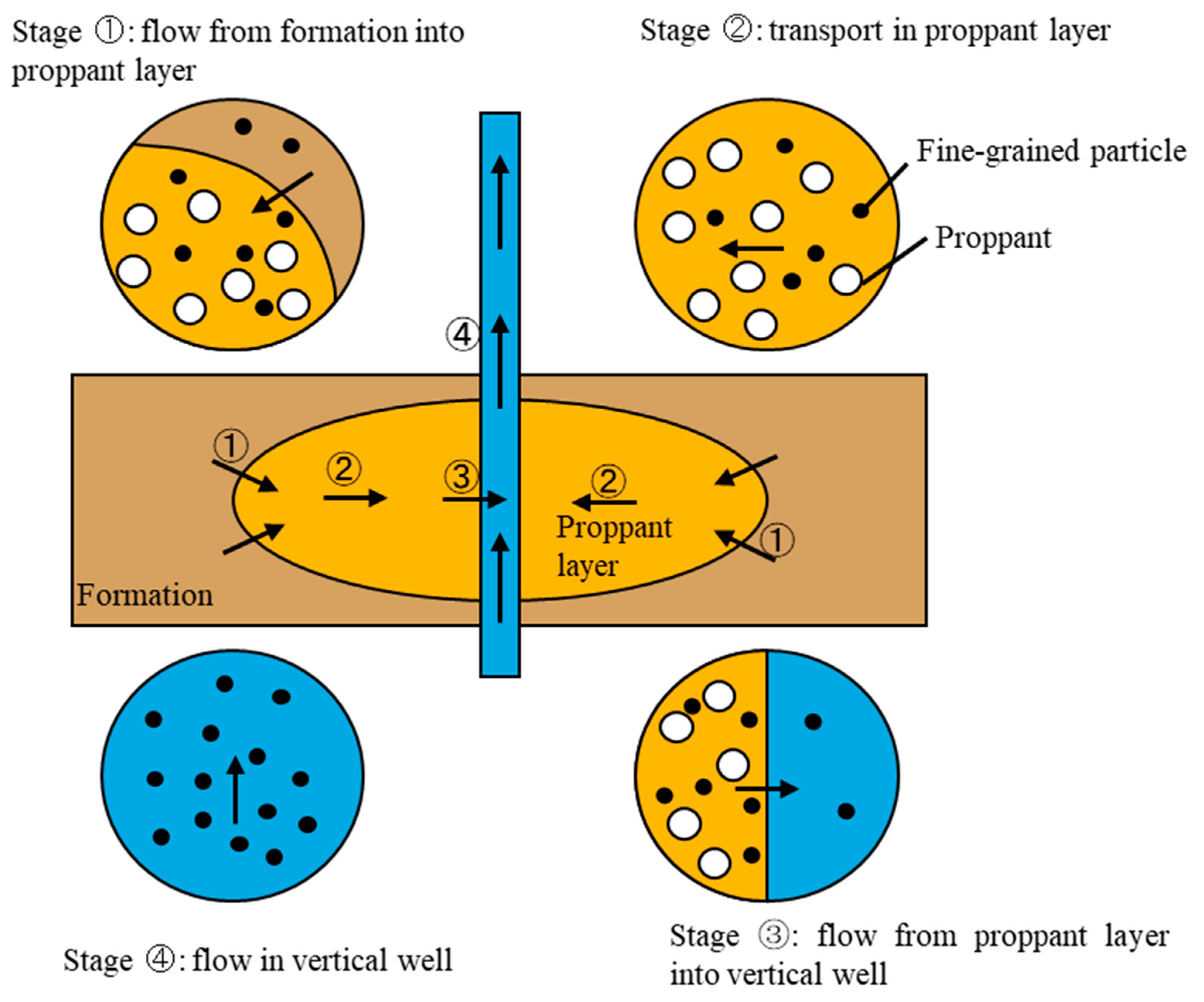
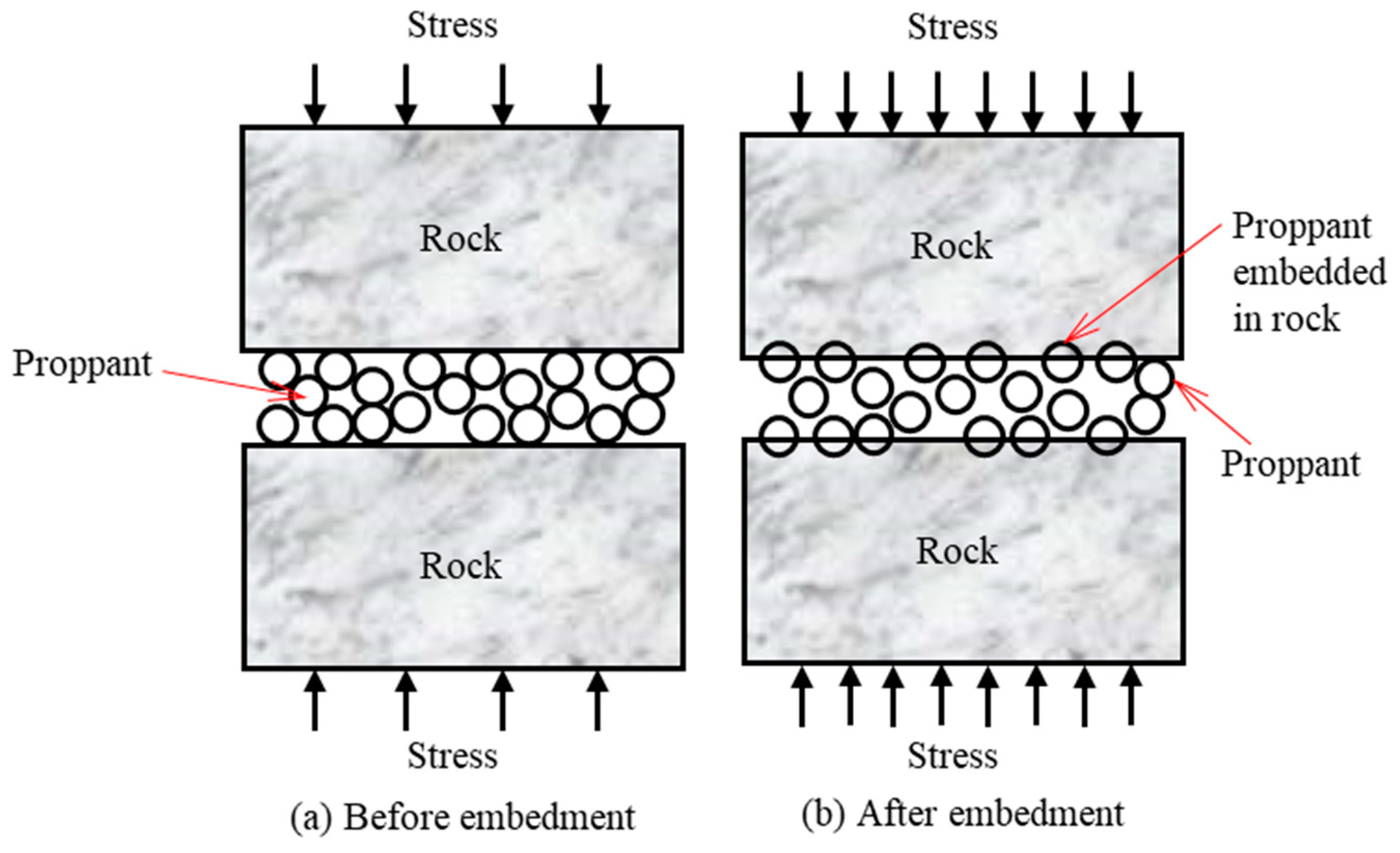
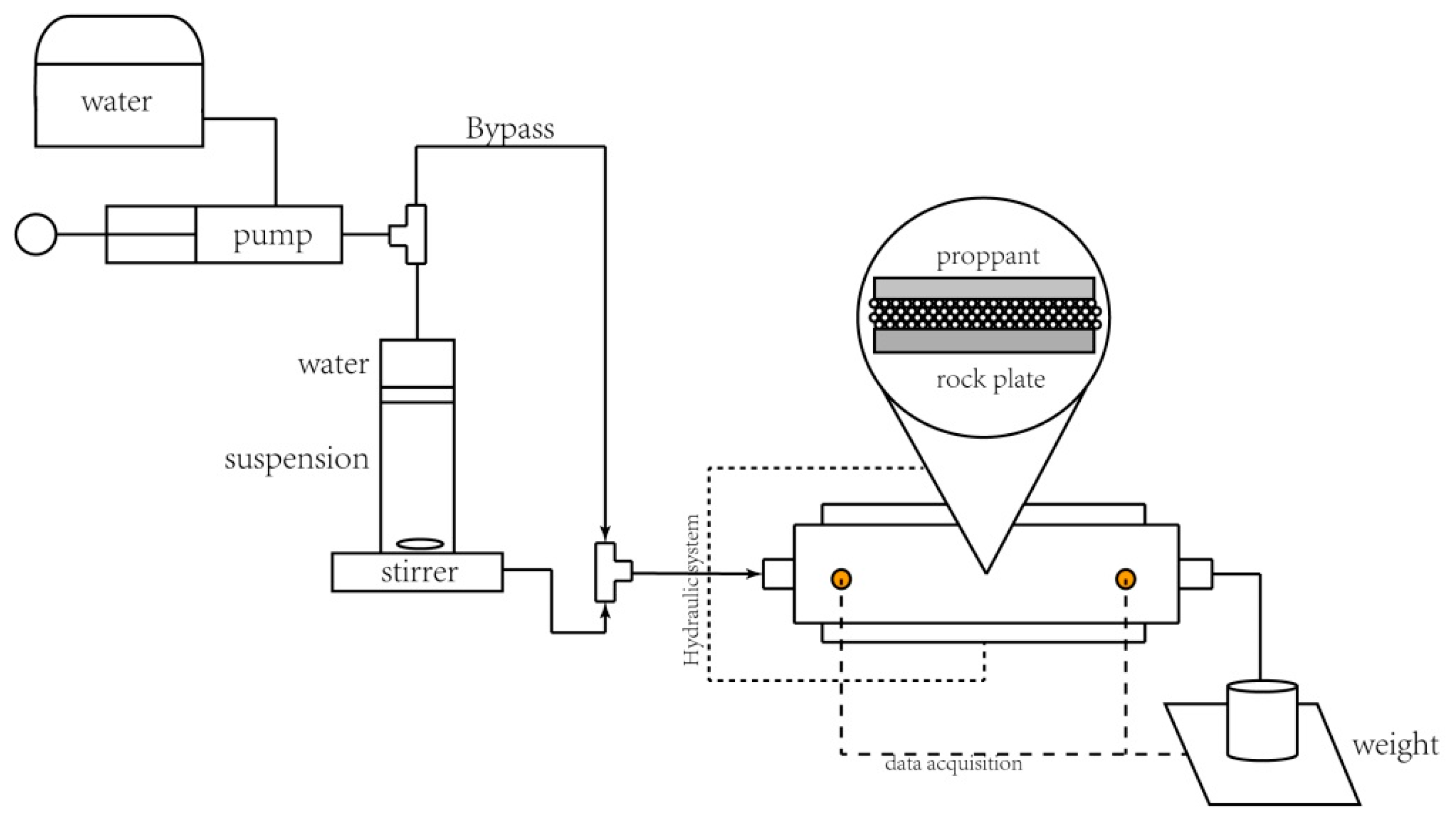

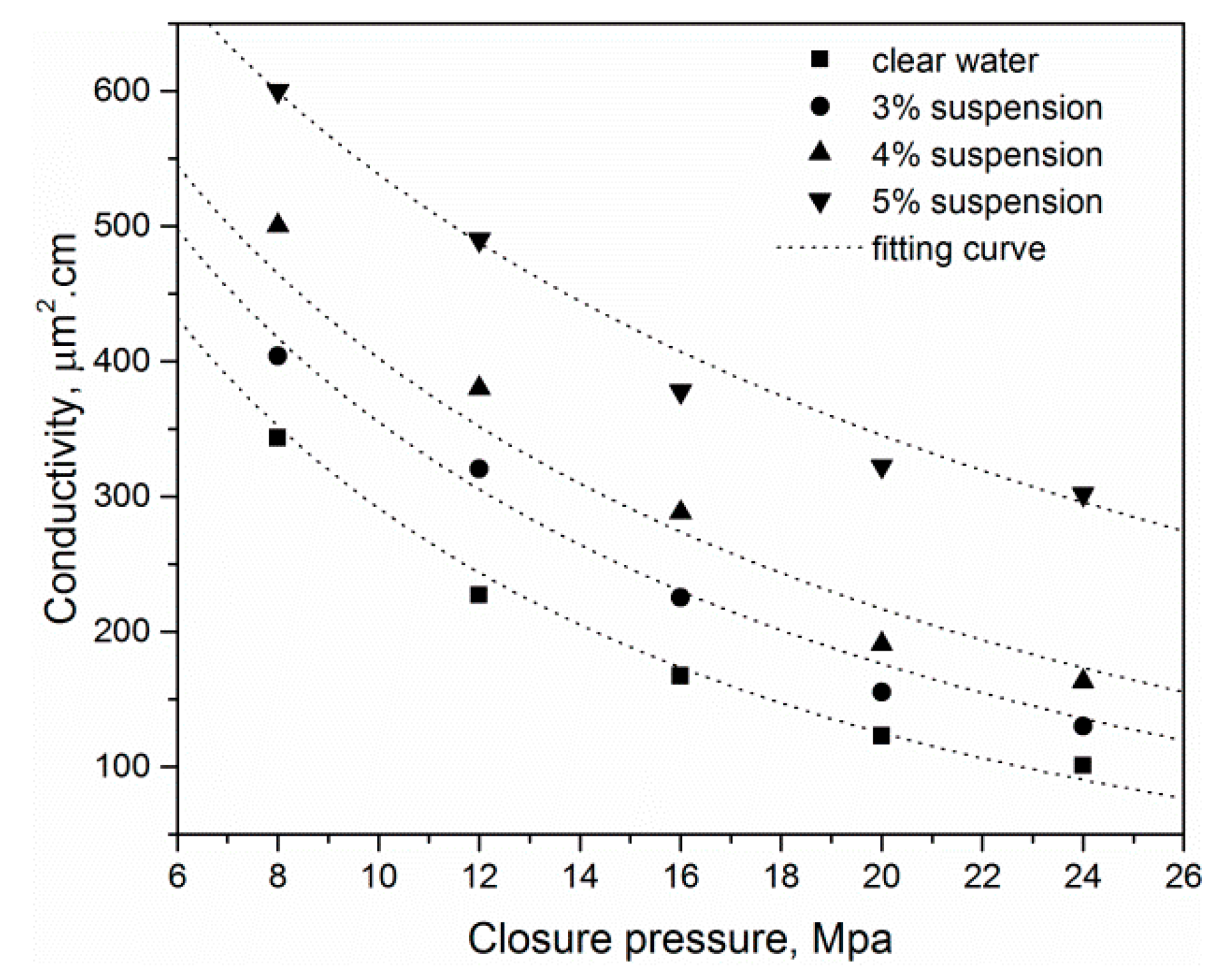
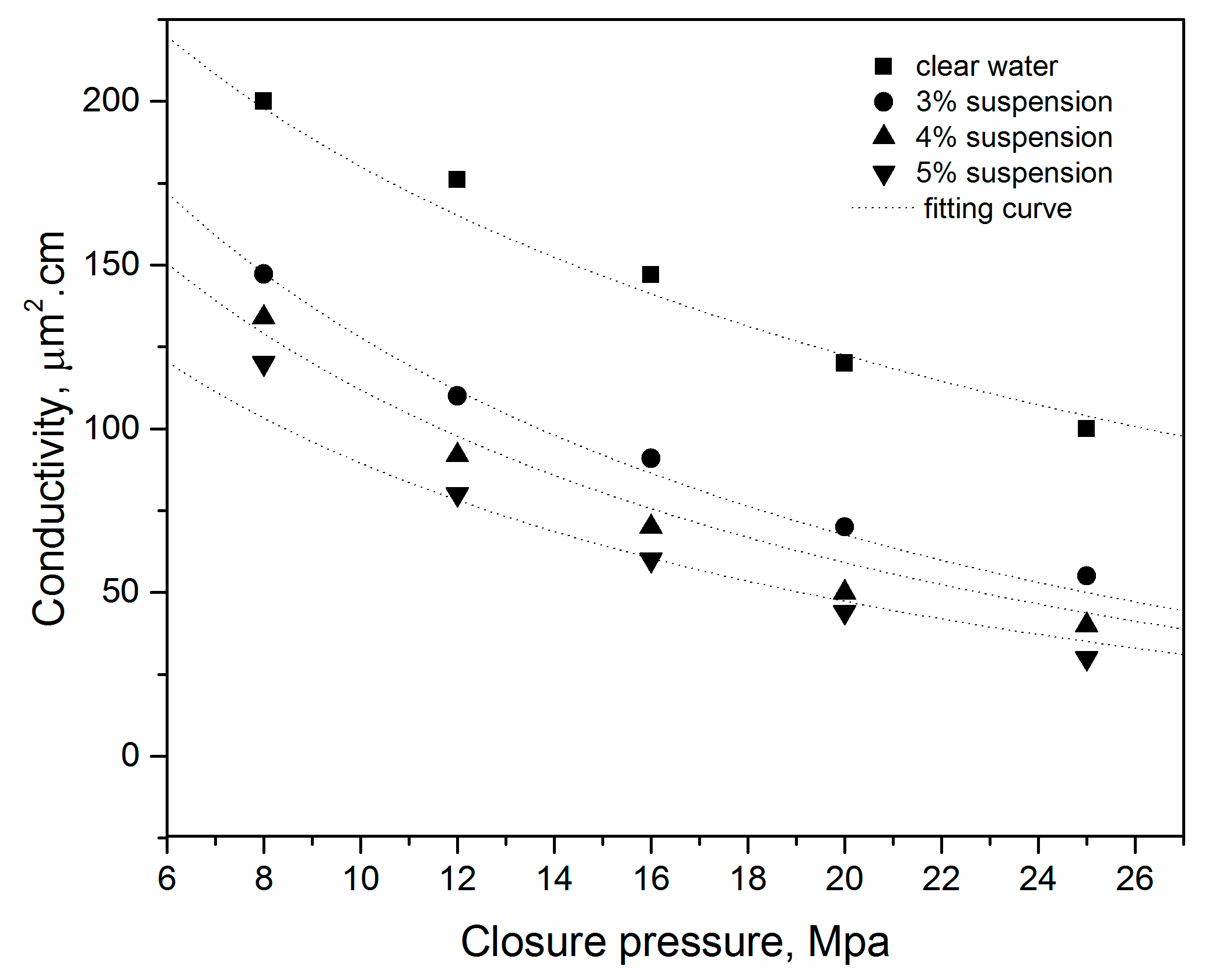
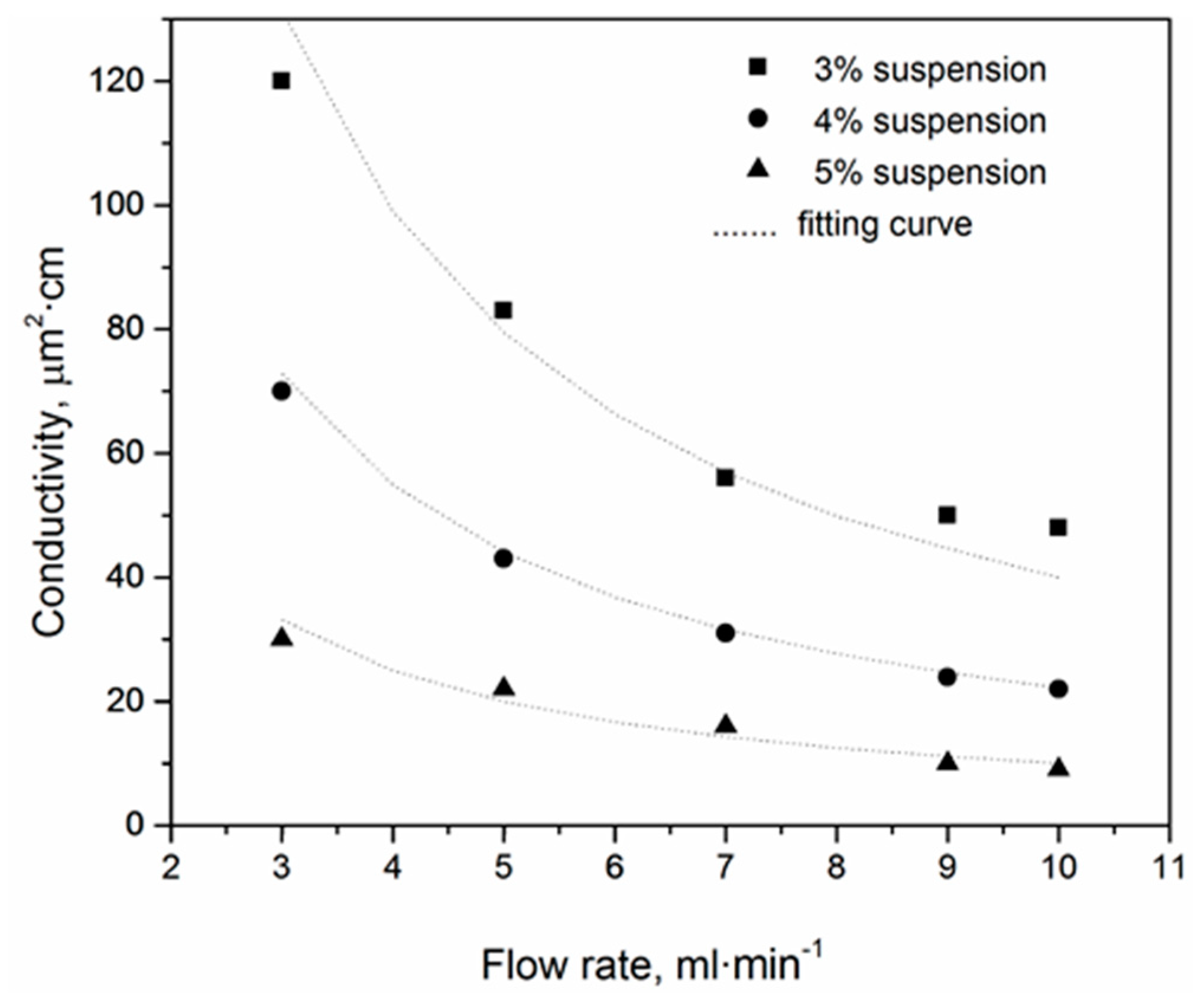
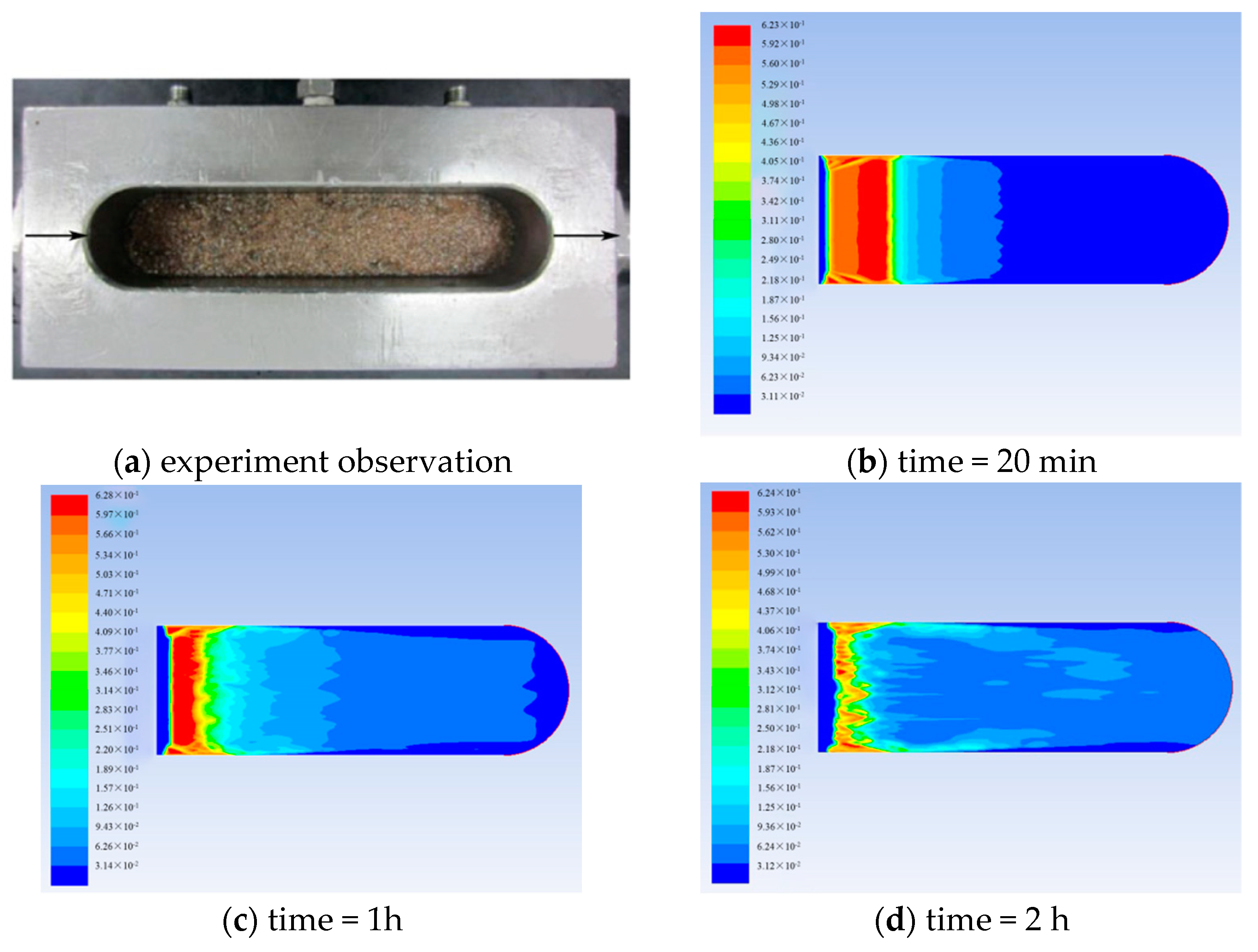

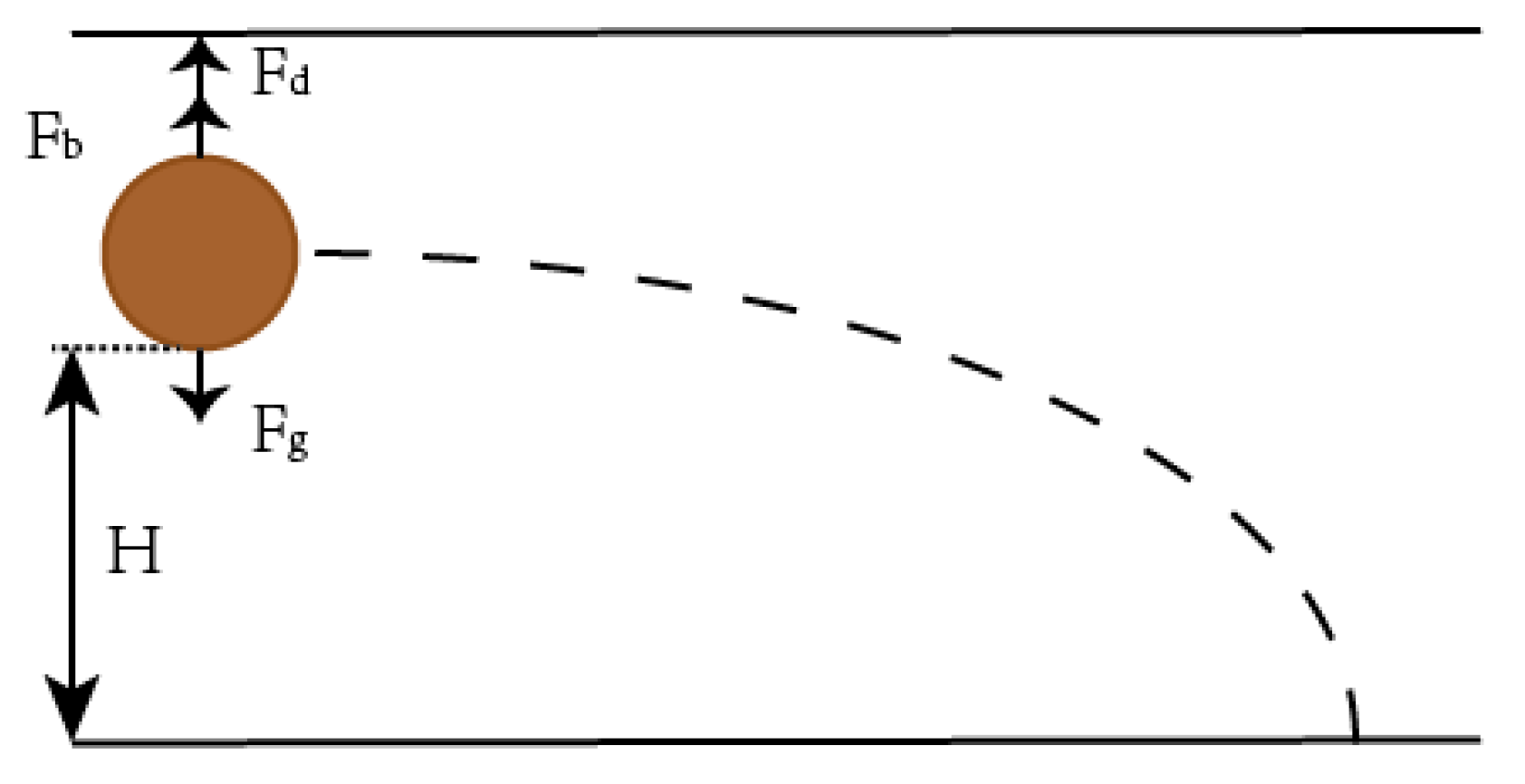
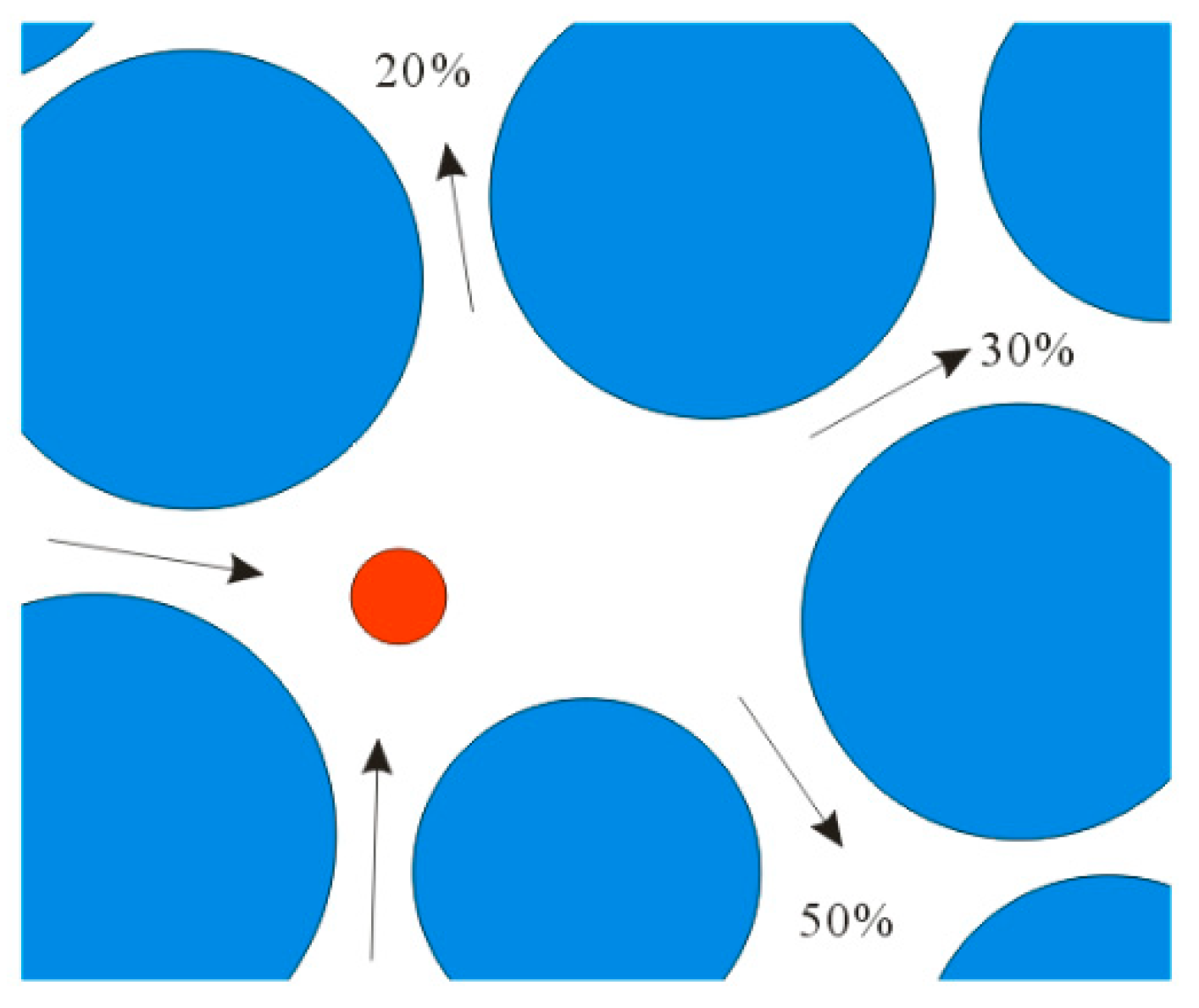

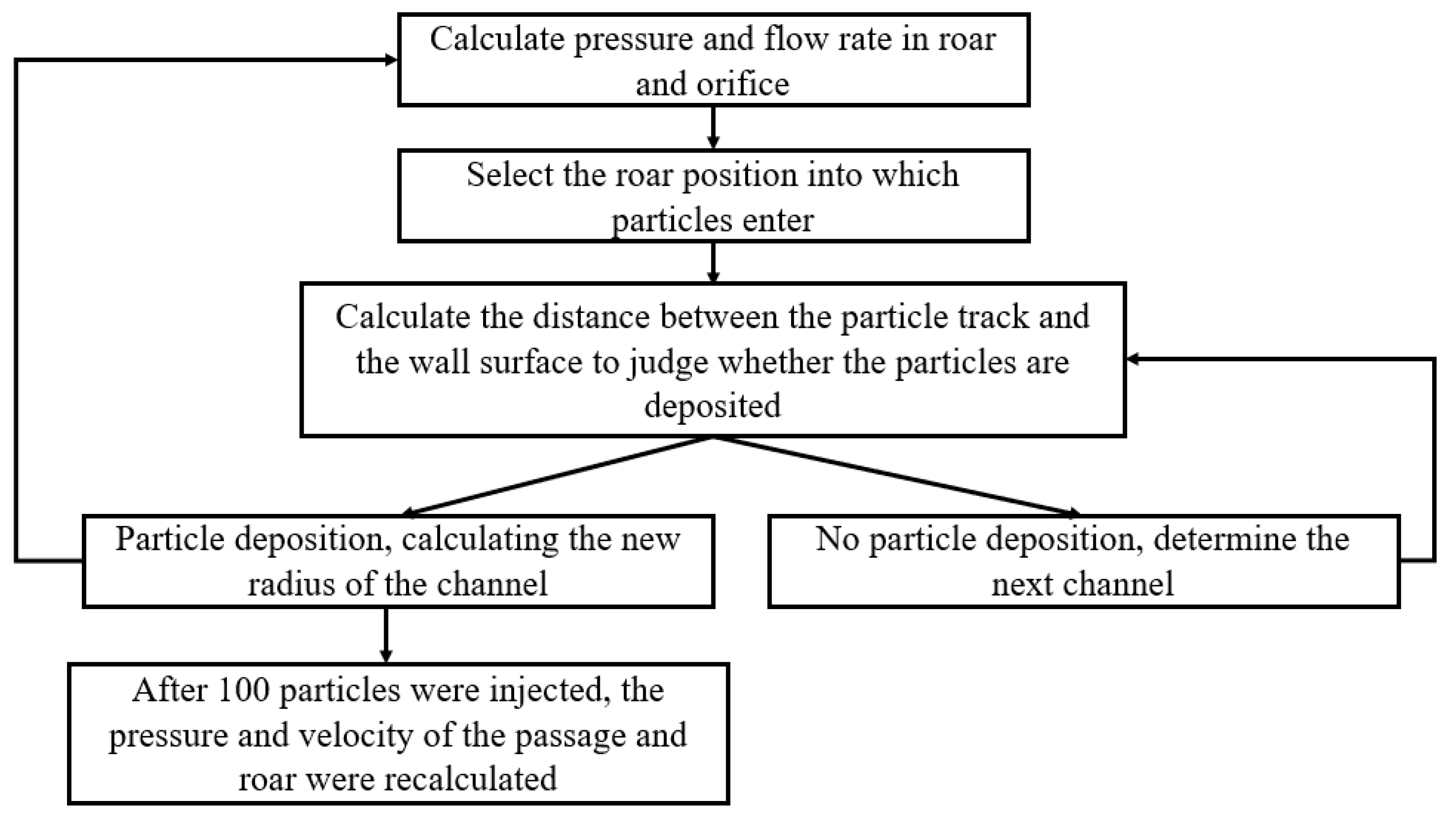

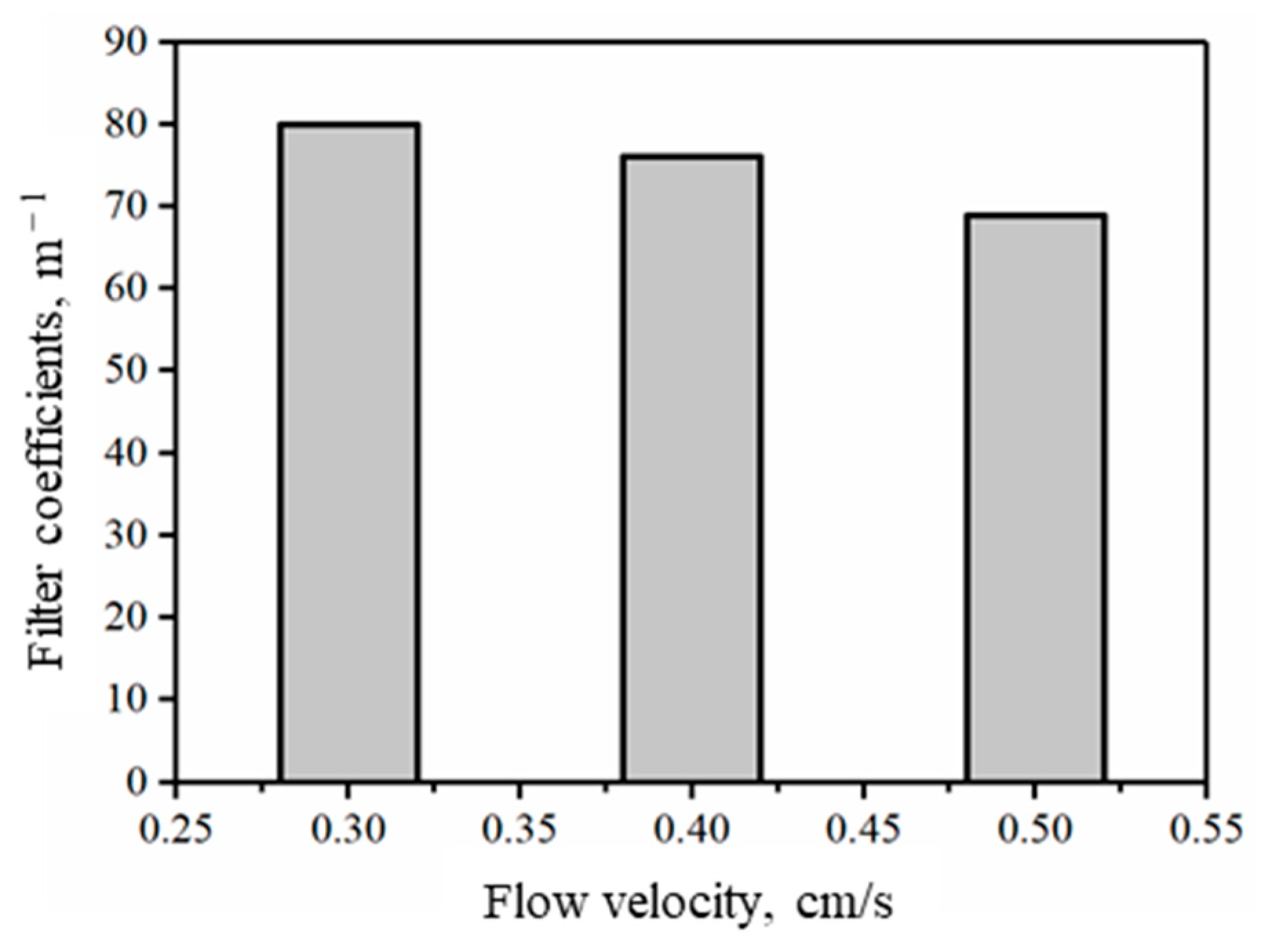
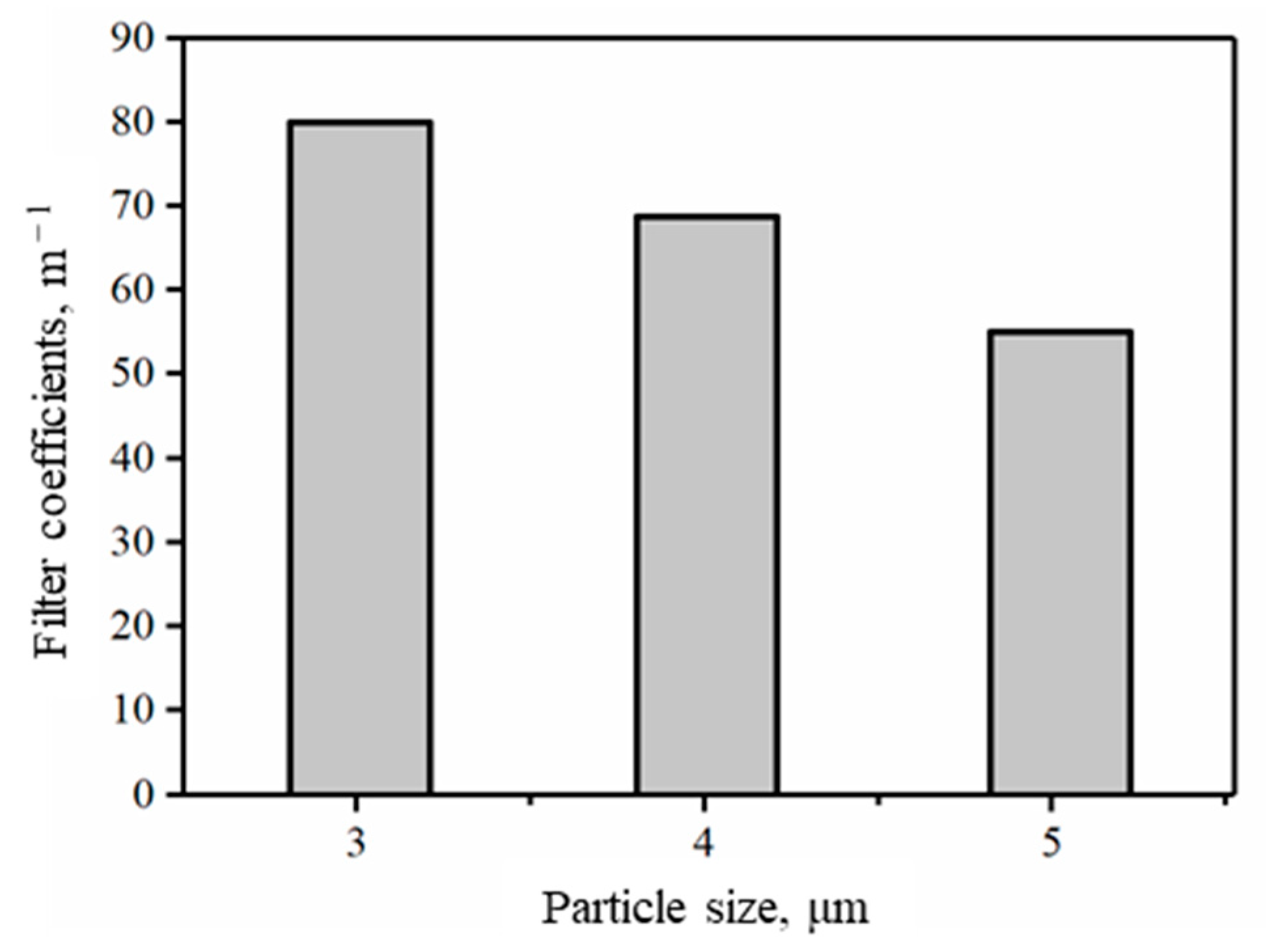
| Parameter | Value |
|---|---|
| Proppant size, d | 20–40 mesh |
| Porosity, ϕ | 22.5% |
| Initial permeability, k | 700 mD |
| Suspension viscosity, μs | 1 mPa·s |
| Injection rate, Q | 10 mL/min |
| Pressure at outlet, P | 1 atm |
| Filtration coefficient, λ | 11.8 L−1 |
| Proppant pack compressibility, α | −0.022 |
| Initial effective stress, σe0 | 0 MPa |
| Damage coefficient | 212 (g/L)−1 |
| Parameter | Value |
|---|---|
| Proppant size, d | 200–425 µm |
| Porosity, ϕ | 20.3% |
| Initial permeability, k | 400 mD |
| Suspension viscosity, μs | 1 mPa·s |
| Injection rate, Q | 200 mL/min |
| Pressure at outlet, P | 1 atm |
| Filtration coefficient, λ | 10 L−1 |
| proppant pack compressibility, α | −0.028 |
| Initial effective stress, σe0 | 0 MPa |
| Damage coefficient | 182 (g/L)−1 |
| Micro Model | Advantages | Disadvantages |
|---|---|---|
| Capillary model | The capillary model is simple and easy to calculate. | The model is too simple to reflect the real core, and the accuracy is not enough. |
| Network model | The model has high accuracy. | The model is relatively complex, and the calculation is complicated. |
| Element model | The model is simple. | The calculation is relatively complex and cannot simulate complex structure. |
| Numerical model | Accurate calculation and comprehensive consideration. | Computations take a long time and require high-performance computers. |
| Name of Parameter | Parameter Choice |
|---|---|
| Pore diameter | 30 μm |
| Shouted the diameter | 30 μm |
| Shouted the length | 200 μm |
| Coordination number | 4 |
| Void ratio | 28.2% |
| Number of particles | 100 |
Publisher’s Note: MDPI stays neutral with regard to jurisdictional claims in published maps and institutional affiliations. |
© 2022 by the authors. Licensee MDPI, Basel, Switzerland. This article is an open access article distributed under the terms and conditions of the Creative Commons Attribution (CC BY) license (https://creativecommons.org/licenses/by/4.0/).
Share and Cite
Zhang, W.; Zhao, Q.; Guan, X.; Wang, Z.; Wang, Z. Experiment and Model of Conductivity Loss of Fracture Due to Fine-Grained Particle Migration and Proppant Embedment. Energies 2022, 15, 2359. https://doi.org/10.3390/en15072359
Zhang W, Zhao Q, Guan X, Wang Z, Wang Z. Experiment and Model of Conductivity Loss of Fracture Due to Fine-Grained Particle Migration and Proppant Embedment. Energies. 2022; 15(7):2359. https://doi.org/10.3390/en15072359
Chicago/Turabian StyleZhang, Weidong, Qingyuan Zhao, Xuhui Guan, Zizhen Wang, and Zhiwen Wang. 2022. "Experiment and Model of Conductivity Loss of Fracture Due to Fine-Grained Particle Migration and Proppant Embedment" Energies 15, no. 7: 2359. https://doi.org/10.3390/en15072359
APA StyleZhang, W., Zhao, Q., Guan, X., Wang, Z., & Wang, Z. (2022). Experiment and Model of Conductivity Loss of Fracture Due to Fine-Grained Particle Migration and Proppant Embedment. Energies, 15(7), 2359. https://doi.org/10.3390/en15072359





